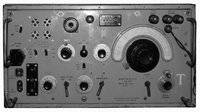Inhaltsverzeichnis
Equipment of the Armed Forces of Great Britain
 From 1929 to 1948, the radio sets of the United Kingdom Armed Forces bore designations along the lines of „Wireless Set No.XX „.
From 1929 to 1948, the radio sets of the United Kingdom Armed Forces bore designations along the lines of „Wireless Set No.XX „.
Nomenclature of United Kingdom Military Material
Nomenclature of the earliest equipment
In the early days of military radio communications, British equipment sometimes bore designations indicating the transmitting power, plus a letter from A for near-frontline use in ascending order in the case of equipment for rearward use, M denoted mobile stations.
Nomenclature of "Wireless Sets" 1929/48
In 1929, a new nomenclature was introduced: The six sets introduced in 1929 were given numbers denoting the distance of use. Set. No.1 was intended for short-distance communications, the No.6 set for worldwide connections.
With the new sets introduced from 1930 onwards, the second digit in the designation stood for the operating distance (x1 for short distance, x6 for long distance), the first digit or prefix increased with each set generation.
For new devices whose development was not yet completed, the future designation was preceded by X.
| Type of unit / purpose | Designation | Successor units |
|---|---|---|
| Short Range Brigade; Artillery/GP | No. 1 | 11, 21, 31, etc. |
| Short Range Division/GP | No. 2 | 12, 22, 62, etc. |
| Medium operating distance, mobile stations | No. 3 | 23, 33, 43, etc. |
| Remote distance, transportable stations, GHQ | No. 5 | 15 |
| Remote distance, transportable stations of the Army chain | No. 6 | |
| later: long distance, special tasks | No. 26 | 36, 46, 76, etc. |
| Armoured Fighting Vehicle (AFV) | No. 7 | |
| later: special tasks | No. 17 | 27, 37, 47, etc. |
| Portable equipment in infantry battalion, „manpack set“ | No. 8 | 18, 28, 38, etc. |
| Armoured Fighting Vehicle, (AFV) | No. 9 | 19, 29, 49, etc. |
| Local control unit for AFV (armoured fighting vehicles) | No. 14 | 24, 34 |
| Jamming Set, jammer | No. 16 | 56 |
| UHF device, effective distance optical visibility | No. 10 | 20 |
Canadian devices without identical British equivalent were given a designation with prefix C.
Australian devices with an identical British equivalent were given a prefix from the 100 - group, for example Wireless Set 101 instead of W.S. 1.
Nomenclature of the British devices of the Larkspur series
The following generations of the Larkspur series were given a designation consisting of a letter and two digits between 1950/1976.
| Power class | Designation | |
|---|---|---|
| Low power | portable, under 5 watts | Axx |
| Medium power | light mobile stations, approx. 10 - 20 watts | Bxx |
| Medium power | heavy mobile stations, approx. 20 - 50 watts | Cxx |
| High power | Truck stations, over 100 W | Dxx |
The numbering was in ascending order; numbers below 30 stand for shortwave stations and numbers above 30 for VHF stations.
Receiving sets were given a designation consisting of the above and /Rxxx with numbers in ascending order.
Nomenclature of the British sets of the Clansman and Bowman series
From 1976 onwards, the British units were given new designations based on the American NATO classification, UK/PRC-3xx stands for portable units and UK/VRC-3xx for vehicle and fixed stations.
In the case of older equipment that continued to be used, UK/VRC-3xx or UK/PRC-3xx was prefixed to the previous number from the Larkspur series, while new equipment was given unused free numbers.
further information
Many thanks to Louis Meulstee and Iain Moffat.
Military Receivers from Great Britain
| PCR | 1944 | Single conversion | LW, MW, SW 5.8-18 MHz | AM |  |
| R107 | approx. 1940 | Single conversion | KW 1.2 - 17.5 MHz | AM, CW |  |
| R1155 | 1940 | Single conversion | 75 kHz - 18.5 MHz | AM; direction finding and homing |  |
Further information on Reception Sets
Military communication sets from Great Britain
| Wireless Set No.12 | 1940 | Transmitter | 1.2 - 17.5 MHz | Transmitter A1, A2, A3 |  |
| Wireless Set No.19 | 1941 | Transceiver | 2 - 8 MHz, VHF 229-241 MHz | Transceiver A1, A2, A3 |  |
| Wireless Set No.31 | 1948 | Transceiver | 40 - 48 MHz | F3 |  |
| Wireless Set No.33 | 1941 | Transmitter | 1.2 - 17.5 MHz | Transmitter A1, A2, A3 |  |
| Wireless Set No.62 | 1941 | Transceiver | 1.6 - 10 MHz | Transceiver A1, A3 |  |
